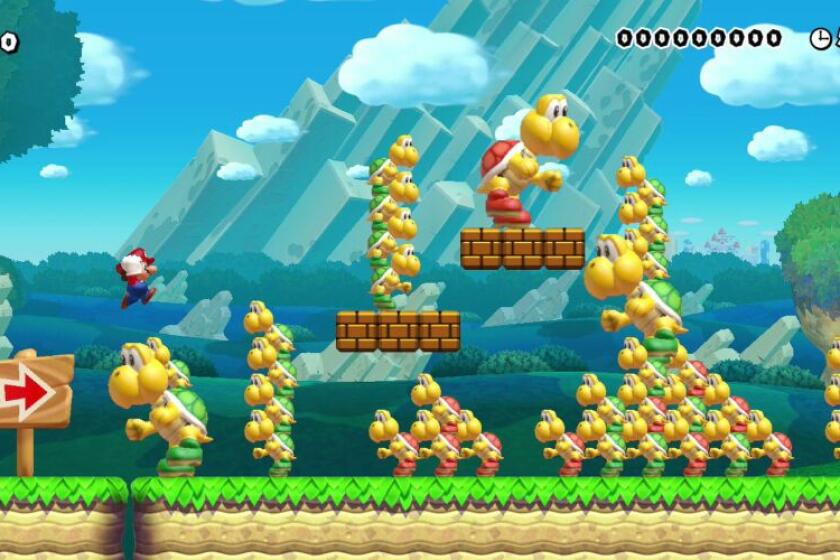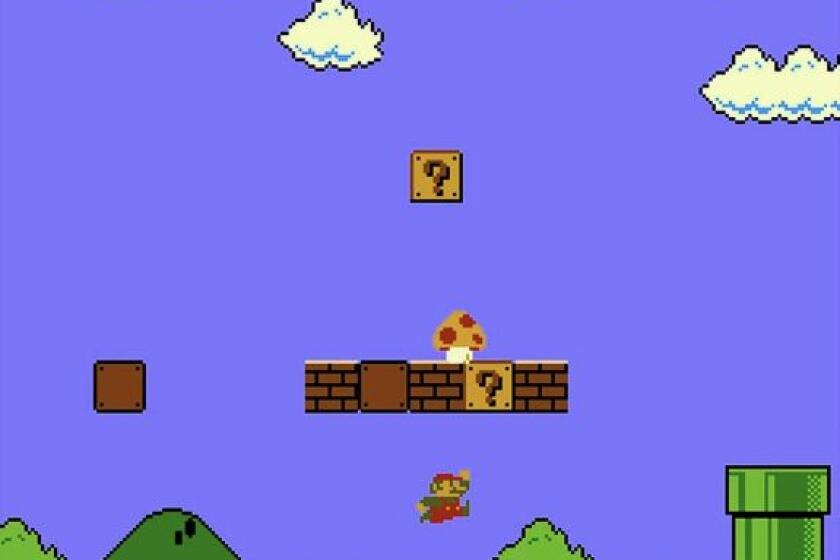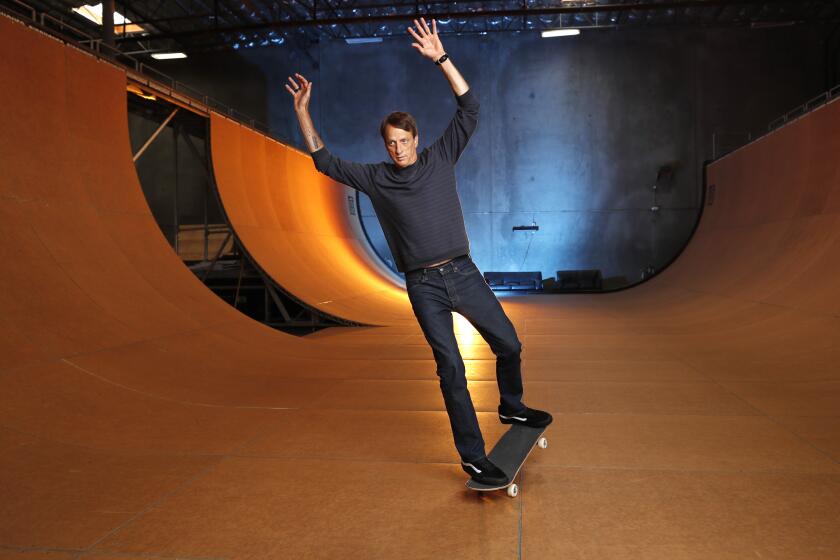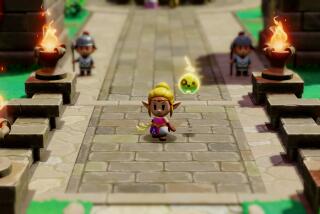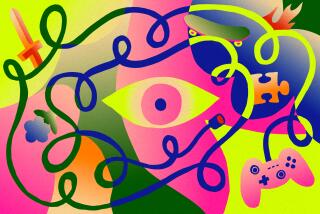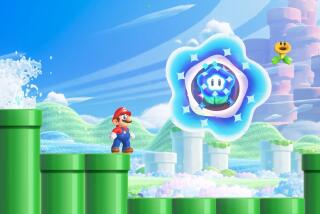Nintendo’s ‘Super Mario 3D All-Stars’ proves why Mario at 35 is more relevant than ever
- Share via
Who is Mario?
For 35 years, Nintendo has placed its mascot in warmly fantastical settings and blessed the character with increasingly zany abilities. Most recently he found a sort of pet hat named Cappy, which gave him the power of possession. Mario has had the capacity to toss fireballs, to fly in a raccoon-like suit, shape-shift into a bee and, my personal favorite, take on feline qualities.
And yet, in 2020 as Nintendo celebrates 35 years of Mario — a character drawn up by game design master Shigeru Miyamoto and known, at first, as Mr. Video — we’re not really any closer to understanding who this plump, mustachioed plumber is.
We know the facts. “Mr. Miyamoto’s image for an action-game character was that he should be someone blue-collar,” Nintendo’s longtime designer and “Mario Maker” producer Takashi Tezuka once told me. And we know Mario has appeared alongside Donkey Kong and raced karts, and that those who get close to him have a tendency to get kidnapped.
I would argue that through all of Mario’s permutations, Olympic-worthy feats and rascally mini-games, not to mention the envious ability to avoid permanent death, there are two distinct eras for the character: the one before the 1996 release of “Super Mario 64” and the one after.
For in 1996 Mario fully transitioned from a symbol or object — albeit one with Everyman appeal, to be manipulated to a game’s needs or the psychedelic whimsies of Nintendo’s developers — into an interactive personality.
Thirty years ago a plump little plumber in red overalls revolutionized gaming.
Nintendo, in the arcade-inspired space of console gaming, has always led when it came to giving games a human feel. Much of this is attributed to Miyamoto’s design sensibilities; over the years he’s been responsible for the labyrinth-like caves of the “Zelda” series, the sci-fi gardens of “Pikmin” and the castles amid the forests of the “Super Mario Bros.” games.
And yet I still remember my first few hours with “Super Mario 64.” I relished them because I didn’t play the game so much as play with the game.
The tasks at hand were beside the point. I was amazed instead at simple details, such as Mario’s pliancy, and the way he could sometimes jump straight into a sign and then bounce backward with a falsetto groan, recognizing the item not just as an impediment to moving forward but as an element that required a reaction. Enemies, too, didn’t move in obvious patterns. They ran toward Mario or scurried away in fear.
“It did something unexpected in that it completely changed the prevailing model in platform games of progressing on a fixed path from left to right in a fixed sequence of levels,” says Richard Thames Rowan, design department chair at DigiPen Institute of Technology. “Instead, it let you go in any direction at all in any order you wanted with lots of hidden content to discover.”
Such a freedom of movement, now relatively expected in most games, completely upended the play objective.
Play shifted from something that was goal-driven to something that was centered on discovery. In “Mario 64,” there weren’t just puzzles or challenges. It’s no wonder that Nintendo opened the game with a giant shot of Mario’s face, letting players tug and tinker with it to generate different expressions.
Here was emotion, and it was in response to how I directed the action. In other words, that sense of feeling was coming directly from the game rather than something I was grafting onto it.
It’s been almost 30 years since the release of “Super Mario Bros.,” and I still can’t get one voice out of my head.
“Nintendo was always unabashedly childlike, playful and exuberant. That emphasis on character — that moment-to-moment interaction — that grows out of games that didn’t take themselves too seriously,” says Eric Zimmerman, a game designer and educator with New York University’s Game Center. “They took the design seriously. But they were the Archie Comics and not ‘The Dark Knight Returns’ of popular culture. There’s a lightness to the content.”
“Super Mario 64” is part of a three-game package being released Friday as “Super Mario 3D All-Stars,” a set that also contains the criminally underappreciated “Super Mario Sunshine” and the starry-eyed wonder of “Super Mario Galaxy.” Nintendo has said the set will be available only through March 31 of next year, a move that has generated comparisons to the consumer-unfriendly approach of the so-called “Disney vault” and is currently driving up EBay prices of the physical Nintendo Switch cartridge for the set.
But it is also an opportunity to purchase video game history. While Nintendo didn’t update the games with modern graphics, as is the tendency in video game reissues, such touches aren’t necessary when the original product feels so assuredly of-the-moment. Mario is an acrobat in this game, his jumps increasing in spectacle — and defying gravity — the higher they get. He can slide through the world, throw a punch and, more importantly, levels are designed to be played and replayed, laid out not in any linear sense but as if they’re each a mini theme park.
A cultural nerve was struck when it was announced that “Tony Hawk ‘s Pro Skater 1 + 2” would be remastered. Hawk even renamed a trick for the game that instantly dominated social media talk.
We can see a goal in the distance, but each step forward is designed to create a new reveal, a new question; the standard “Super Mario Bros.” blocks here aren’t simply given to us, the player must wander to discover the not-so-hidden secrets that will allow them to be utilized.
In a brief phone chat this week, Zimmerman brings up the term “weenie” when discussing “Super Mario 64,” referring to a word used by Walt Disney to describe a visual cue that propels guests forward through the theme park.
“I always think of ‘Mario 64’ with that concept, because there’s always the tease of the distance,” Zimmerman says. “Now it’s a staple of these large 3-D games. You’ll catch a glimpse of the pinnacle, but this helped invent those.”
“Super Mario 64” also solidified the game camera movement. The game put a turtle-like character, Lakitu, in the role of a cameraman, giving players limited control over the moment but also making it clear to the player that how Mario and the camera moved would be dependent upon each other, an important change that helped do away with the loss of a sense of direction in earlier 3-D games. Today’s audiences may find the camera controls a little sticky, but my enjoyment of the game wasn’t significantly deterred and I prefer the idea of a game being preserved rather than reimagined.
While I’ve had a copy of “Super Mario 3D All-Stars” for the better part of a week, I’m not very far along in any of the three games in the package. I’ve spent the most time with “Super Mario Sunshine.” Its message of climate change — Mario is essentially cleaning an island paradise ruined by outsiders — feels the most thematically relevant, but I’ve been jumping among all three games and even restarted 2017’s “Super Mario Odyssey,” an absolute joy that takes bits and pieces of every “Mario” creation and seemed to finally answer the question: Who is Mario?
The answer: It doesn’t matter. In “Super Mario Odyssey” Mario can more or less become a dinosaur or a car.
Miyamoto, in an earlier interview, said that when he drew Mario for the very first time, “I thought, ‘Oh, I like this character. I want to use him in all of my games going forward.’ At the time, I was calling him Mr. Video, for video games.”
In the same way Mickey Mouse or Bugs Bunny could shape-shift with an animator’s whims, so could Mario for the video game medium.
The only difference is that before “Super Mario 64,” he was a character who could move up, down, left and right. After “Super Mario 64,” he had life. We didn’t view Mario’s worlds so much as enter them.
“This game is a pivot point,” says Zimmerman. “It leans on all the gameplay innovation and style of Nintendo, but it’s forward-looking. It was so inventive that it paved the way for contemporary video games. There aren’t many video games that fit in that category. ‘Doom’ comes to mind. But the game really does hold up.”
So who is Mario at 35? An unlikely video game hero, an underdog in plumber overalls who continues to show us the possibilities and joys of video games.
More to Read
The biggest entertainment stories
Get our big stories about Hollywood, film, television, music, arts, culture and more right in your inbox as soon as they publish.
You may occasionally receive promotional content from the Los Angeles Times.
